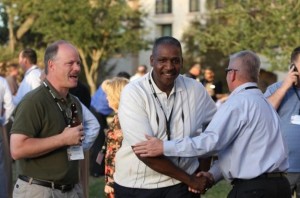Face-to-Face Communications in a Digital World
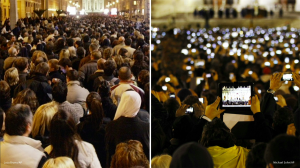
These pictures are from the Vatican. The picture on the left is Pope Benedict leading a mass in 2005 and the one on the right is Pope Francis in 2013. The main difference is obvious. The 2013 picture shows an extraordinary amount of digital devices capturing the moment. People want to be part of live events and people want social media to be part of these magical moments.
Digital communications are great in terms of capturing and sharing it with our family and friends. In our business network, digital communications help us move large amounts of information around the globe instantly and gives us the ability to work with dispersed groups of people.
Americans spend 520 billion minutes a day on-line (2.5 hr./day/for each American). Most advanced countries are proportionally the same. The ability to take advantage of the benefits of technology in terms of speed, logistics and moving information around is infinite.
People now have the ability to have more connections. But at the same time people are feeling more isolated and lonely.
Also, the quality of our time together is not always enriching. When I see the coveted 15-35 year olds out for dinner most of them are responding to texts and tweets. They miss out on the human interaction with the people right in front of them. When you go to concerts most of the audience are taking selfies and tweeting instead of enjoying the music and the experience.
What we do with our digital community can make our lives easier but it is the face to face experience that we live for. It can make us healthier, happier and smarter.
Face-to-face contact matters. Human beings are hard-wired to connect to other human beings. We need the real, in-the-flesh encounters.
To give us context we will share the findings of Susan Pinker who has just released the book “The Village Effect”. Pinker explains what happens to us when we are together and the positive effect that it has on us.

The Village Effect explains “that the tight bonds of friendship and love heal us, help children learn, extend our lives and make us happy. Looser in-person bonds matter, too, combining our close relationships to form a personal “village” around us, one that exerts unique effects. Not just any social networks will do: we need the real, in-the-flesh encounters that tie human families, groups of friends and communities together. Her results are enlightening and enlivening, and they challenge many of our assumptions. Most of us have left the literal village behind, and don’t want to give up our new technologies to go back there. But, as Pinker writes so compellingly, we also need close social bonds and uninterrupted face-time with our friends, families and business associates in order to thrive―even to survive.”
In this newsletter we will couple these insights of face to face communications with our team’s experience in producing meetings and live events to demonstrate how we can make an impact, create content and expand our reach to our audiences.
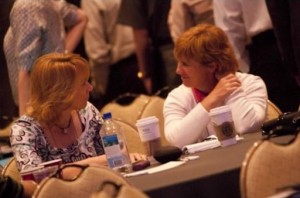
Relationships can be developed and are critical to our survival. Critical to our personal survival as it makes us healthier. Critical to our business survival as it expands our village and eventual success.
When you are with people your body spreads neuropeptides that enhance your experience and makes you healthier.
Why do women live longer? Women typically have stronger circles of friends than men. They chat more, have more meals together and meet more on a weekly basis.
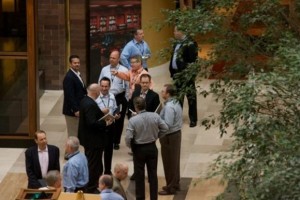
Social Networks are formed with our friends, mentors, employees, referral sources, customers and suppliers. Having a sense of belonging to a group and making your audience feel part of that group is a best practice that needs to be part of each event.
Susan Pinker named her book “The Village Effect” because it is village life that has a strong sense of belonging. In a village, everyone knows your name, looks out for each other and has your back. The benefits of physiological immunity, enhanced learning and the restorative power of mutual trust are strong.
Religion helps people live longer, not so much because of the redemptive power of prayer as to the fact that religion helps bring human beings together. Belonging to a religious group is a lot like living in a village.
A feature of powerful and effective business networks is amassing a circle of friends, mentors, referral sources or as I like to say our a thousand points of light.
The following is a newspaper article that I wrote which included these ideas.
Thousand Points of Light – “I have spoken of a thousand points of light, of all the community organizations that are spread like stars throughout the Nation, doing good.”
—George H. W. Bush, 1988
While President Bush was not always known for his eloquence this phrase has always stuck by me. The visual of looking up and being amazed and sometimes overwhelmed by the brightness of our universe has always inspired me.
In our business world, I live by the notion “I have met a thousand points of light of meeting planners, event producers, writers, speakers, av technicians, graphic artists, videographers, hotel sales staff and their convention services managers throughout our nation (and world) doing good work for our client’s corporations and associations”.
One of the great things about our business is meeting the talented and hard working people who understand the power of face-to-face communications and event marketing. Like shooting stars our paths cross for three-to-five days where anything is possible.
As the universe keeps expanding so should your contacts by adding friends, family and people you meet at networking events. Create your own constellation of people and make those lights shine brighter. Simple actions can lead to impressive results. Keep people up to date with what you are doing and with emails/text messaging it makes it so easy.
If you get an e-mail promoting a hotel or speaker from one of your suppliers, send an email back telling them how much you liked it and let’s get together for coffee.
If one of those people needs a favor, like forwarding their child’s resume to someone you might know, do it.
Send a hand written note.
These Thousand Points of Light will brighten your career with referrals, ideas for events and friendships.
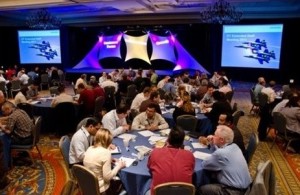
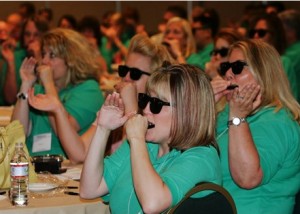
Group Learning & Shared Experience
Face-to-Face learning and sharing are key elements of being together.
Two key benefits are:
– Easy spreading of influence
– People who belong to groups get things done to affirm their bonds.
While attending a religious service you are prompted to stand, bow and kneel, sing or clap in unison. You know how visceral persuasive it feels to be one of many.
Being a Chicago sports fan there are many examples of a group shared experience such as singing the National Anthem at the Chicago Blackhawks game and the song that is played after each goal. At the Cubs games during the seventh inning stretch it’s singing the “Take Me Out to the Ballgame” or when they win it’s singing “Go Cubs Go”.
Doing things together in an arena or ballpark induces a sense of being part of a group.
Doing things together in the same meeting room, can induce a sense of mutual trust and shared influence begins.
Now how do we take these findings and turn it into a tool for effective leadership.
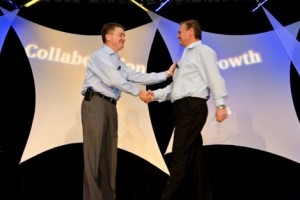
Relational Leadership
Chris Long, assistant professor of management at Georgetown University’s McDonough School of Business recently wrote in a research paper published in the journal Organization Studies in 2014 that found relational leadership is key to building trust among employees. The paper defined relational leadership as “taking an active role in understanding the needs, aspirations, challenges and skills of the people you lead.” How does one do that, “actively demonstrate concern and understanding by developing substantive knowledge of their followers through social exchanges.”
“Talk to people. Care about what they have to say. Listen.”
“Where people really get that deep trust is when they feel the person in charge listens to them and gives them the opportunity to do their best. Obviously a CEO can not know the age of the children of each of their employees and whether they are playing t-ball or piano. It just means that, at the top, you set an example by getting to know the people around you, and make it clear you expect those people to do the same with those people around them.”
“You set a precedent of acknowledging that actual human relationships are part of how you do business.”
“Seek feedback fearlessly.”
The very heart of a great meeting is community and shared mission. Especially for the next generation of employees who are more likely to be motivated by mission than money.
Let’s take a look at how we can incorporate the features and benefits of Face-to- Face Communications, Relationships, Social Networks and Group Learning/Shared Experience into our live events.
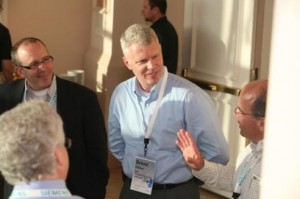
Action Steps:
The following are ways to help you make your audience feel part of your group by listening and engaging them throughout your event.
Pre-Event Surveys – Find out what is important to them and include it in your agenda.

”Ask Me About” Name Badges – In your registration site ask attendees to list three things that they want to talk about both on a business and personal level. Then include their responses onto their name badge. It is a great way to start conversations.
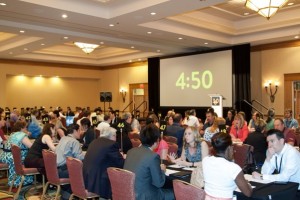
“First Timer Networking Session” – This is a great way to make the newest people in your organization feel part of the group with a speed networking session pre-welcome reception.
Welcome Reception – Make sure your leadership and executives are there and accessible to everyone and not just hunkering down with other executives at a table. They should be there early on to meet, greet and listen to as many of your attendees as possible.


General Session Room Layout –
Consider using a Diamond Thrust Stage as it gets the audience closer to speakers. The audience can now see the faces of other attendees.
Use Crescent Seating at Rounds as it is more networking friendly than theatre or classroom seating
If it is an internal meeting spread out your executives at each table. If it is a customer event spread out employees at each table as host of each table
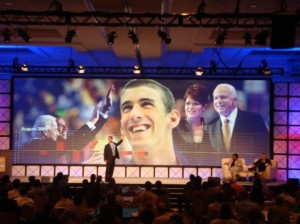
Screen Graphics – Use a concept called Spatial Parallelism. Use lots of pictures and a minimal amount of words. This learning concept takes advantage of our capacity to reason with multiple images that appear simultaneously within our eye span.
Audiences are able to select, sort, edit, reconnoiter and review information and all of this keeps them engaged. By leading your audience with information they are able to come to the conclusion themselves instead of you just telling them.
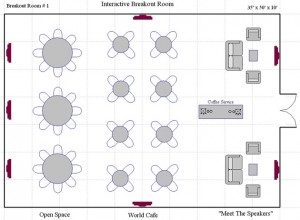
Breakout Sessions – Use interactive room layouts to get your attendees to talk so you can listen.
To make these breakouts more engaging we suggest the following group methods to present and discuss issues and ideas that are important to your participants in a very interactive way. Not only are these methods different than a typical broadcast approach supported by PowerPoint, but the room set-up is different as well.
- Open Space – This approach brings people together to discuss issues and opportunities related to a specific topic. Participants volunteer to identify specific issues and then convene into small groups to discuss. The group self-organizes to determine the agenda, discuss the issues and capture the output. Perhaps a member of your staff and other topical experts would be present to provide advice and help guide the discussions.
- World Café – A café-like atmosphere is created where participants discuss an issue at small tables. At regular intervals, people move to different tables to learn something new about the issue or topic that is important to your participants. We like to call this approach “speed learning!”
- “Meet the Speakers” – One of the comments we often hear is, “It would really be nice to meet the general session speakers.” We can create a casual environment where participants can come in and meet face-to-face with your executives and other industry experts after the general sessions.

Digital Flipcharts – You capture by topic and sub topic ideas, comments and questions digitally. It makes the audience feel like you are listening to them especially when you use this information to improve products, services and employee issues.
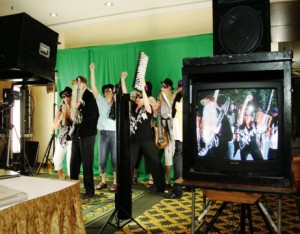
Evening Events – This is where listening can really get going especially after a few cocktails. Make it fun, interactive and again senior management needs to be part of the fun and be accessible.
Summary
“The Power of Face to Face Communications is derived from the positive physical changes that take place when we are together. Feel good neuropeptides and endorphins are released into our bodies. Reading people’s feelings and intentions from their faces and showing trust by touching them are crucial interactions that we humans crave.
Being with teammates fosters trust and better performance because we see the honest signals communicated through body language and hear the tone of their voice. These face to face signals stimulates the brain’s wheels of attachment and trust.”
Face to Face Communications are more effective than digital communications when you need to:
- Persuade and Encourage an Audience
- Feedback
- Recognition
- Build Trust
Next time you are planning an event find that great balance of face time and screen time.

